At Glowskinhub.com, we believe beauty isn’t just a look—it’s a feeling
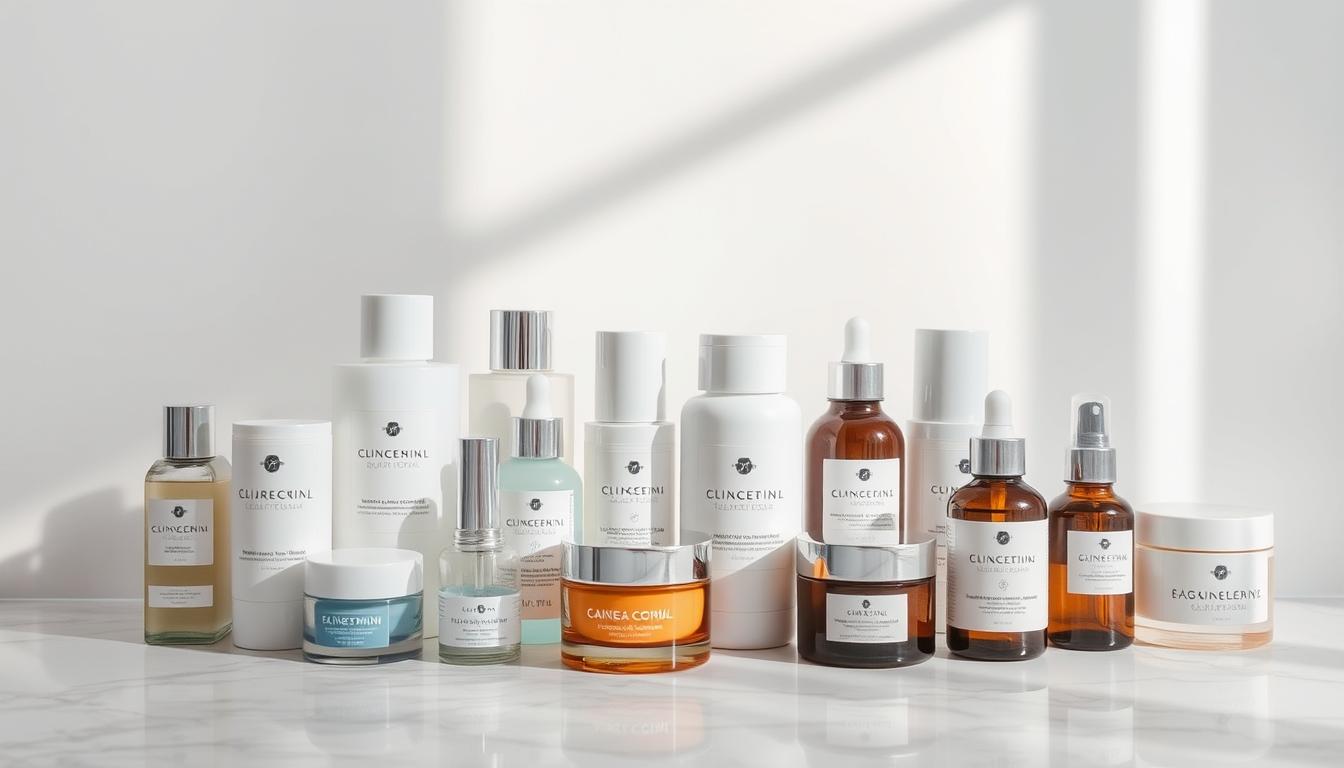
Caring for Combination Skin: Tips and Tricks
Dealing with combination Skin can be challenging. It requires a delicate balance between controlling shine in some areas and hydrating dry patches.
A well-crafted skincare routine is essential for managing this Skin type. By understanding your Skin types and using the right products, you can achieve a more balanced complexion.
Finding the right balance is key. A tailored approach helps to control oil production, reduce dryness, and promote overall Skin health.
Key Takeaways
- Understand your Skin type to create an effective skincare routine.
- Balance oil control and hydration for combination Skin.
- Use products suitable for your Skin type.
- A consistent skincare routine promotes overall Skin health.
- Be patient and adjust your routine as needed.
Understanding Combination Skin
Managing combination Skin requires a deep understanding of its unique characteristics. This Skin type is characterized by the presence of both oily and dry areas on the face.
What Defines Combination Skin
Combination Skin is defined by its mixed oily and dry areas. Typically, the T-zone (forehead, nose, and chin) is oily, while the cheeks are dry or normal. This contrast occurs due to the varying density of sebaceous glands across different facial areas.

The T-Zone and Dry Cheeks Dynamic
The T-zone tends to be oilier due to a higher concentration of sebaceous glands, making it prone to blackheads and acne. In contrast, the cheeks can be dry or normal, sometimes experiencing tightness or flakiness. Understanding this dynamic is crucial for balancing skincare.
How Combination Skin Differs from Other Types
Unlike normal, dry, or oily Skin, combination Skin requires a tailored approach. It demands products and techniques that address both oily and dry areas without exacerbating either condition. Recognizing these differences is key to effective skincare.
By understanding the intricacies of combination Skin, individuals can better navigate the complexities of their Skin, leading to a more effective skincare routine.
What Causes Combination Skin
Understanding the root causes of combination Skin is crucial for effective skincare. Combination Skin is a complex condition influenced by multiple factors.
Genetic Predisposition
Genetics play a significant role in determining Skin type. If your parents have combination Skin, you’re more likely to experience it too. Genetic predisposition can affect the Skin’s natural balance, leading to the characteristic mix of oily and dry areas.
Environmental Triggers
Environmental factors such as humidity, temperature, and pollution can significantly impact combination Skin. For instance, high humidity can exacerbate oiliness in the T-zone, while dry air can dry out the cheeks.
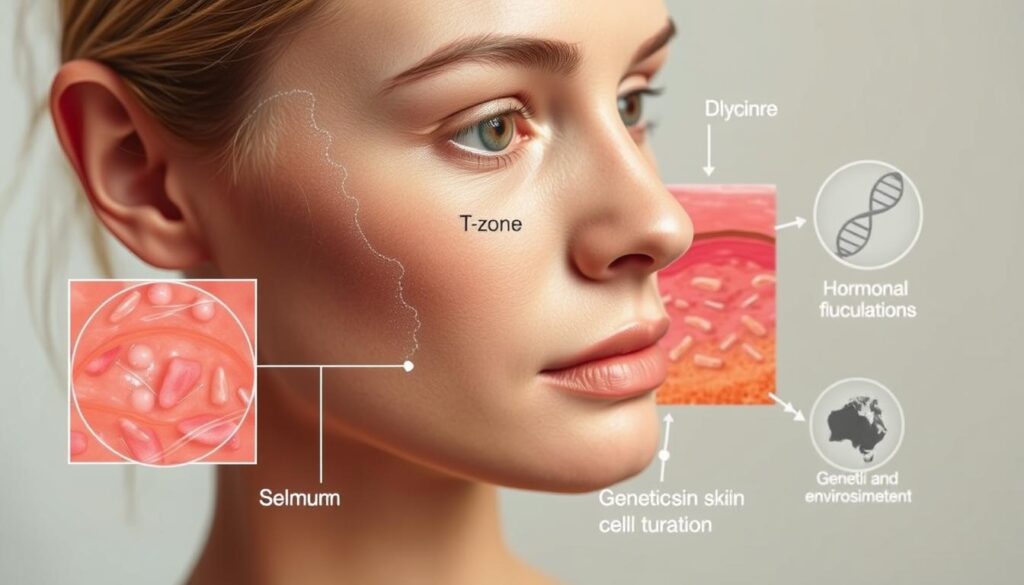
Hormonal Fluctuations
Hormonal changes can affect Skin oiliness and dryness. During puberty, menstruation, pregnancy, or menopause, hormonal fluctuations can lead to changes in Skin condition, contributing to combination Skin.
Age-Related Changes
As we age, Skin’s natural ability to regulate itself can diminish. Older adults may experience a shift towards drier Skin, while the T-zone remains oily, exemplifying combination Skin.
| Factor | Impact on Combination Skin |
|---|---|
| Genetic Predisposition | Influences Skin type and balance |
| Environmental Triggers | Affects oiliness and dryness |
| Hormonal Fluctuations | Changes Skin oiliness and dryness |
| Age-Related Changes | Diminishes Skin’s regulatory ability |
Identifying Your Skin’s Unique Needs
Identifying your Skin’s unique needs is the first step towards achieving a balanced and healthy complexion. To do this effectively, you need to understand the specific characteristics of your combination Skin.
Self-Assessment Techniques
Start by conducting a simple self-assessment. Wash your face with a gentle cleanser and wait for about an hour without applying any products. Observe your Skin’s condition: note areas that become oily, dry, or remain balanced. This simple test can help you understand your Skin’s natural behavior.
Another technique is to use a Skin diary or app to track changes in your Skin over time. Record any changes, reactions, or observations. This can help identify patterns and specific needs.
Tracking Seasonal Variations
Combination Skin can change with the seasons. In colder months, Skin may become drier, while in warmer months, it may become oilier. Tracking these changes can help you adjust your skincare routine accordingly.
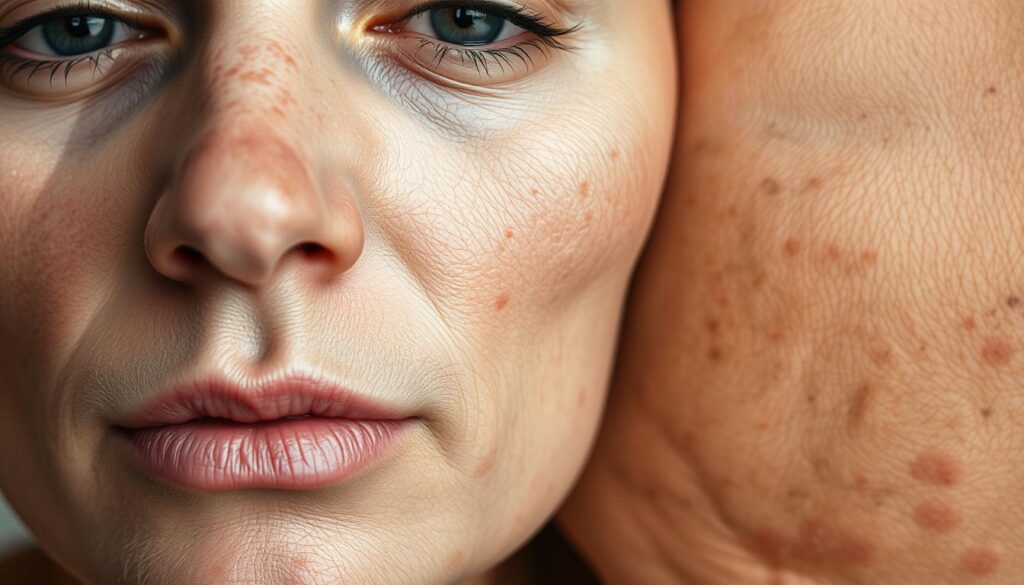
When to Consult a Dermatologist
If you’re struggling to manage your combination Skin or if you notice persistent issues like acne, redness, or sensitivity, it may be time to consult a dermatologist. A professional can provide personalized advice, diagnose underlying issues, and recommend treatments tailored to your Skin’s needs.
| Skin Issue | Possible Cause | Recommended Action |
|---|---|---|
| Excessive oiliness | Overactive sebaceous glands | Use oil-control products, consider clay masks |
| Dry patches | Lack of moisture, harsh products | Apply hydrating masks, switch to gentle products |
| Acne breakouts | Clogged pores, bacteria | Use non-comedogenic products, consider spot treatments |
Creating a Basic Skincare Routine for Combination Skin
A well-crafted skincare routine is essential for managing combination Skin effectively. It involves a delicate balance between controlling shine in the T-zone and nourishing dry areas on the cheeks.
Morning Routine Step-by-Step
Begin with a gentle cleanser that won’t strip your Skin of its natural oils. Follow up with a toner to balance your Skin’s pH. Apply a lightweight moisturizer that hydrates without clogging pores. Don’t forget a broad-spectrum sunscreen with at least SPF 30.

Evening Routine Breakdown
Start by removing makeup and sunscreen with a gentle makeup remover. Cleanse your face with a mild cleanser, then use an exfoliating toner 2-3 times a week to help control blackheads and whiteheads in the T-zone. Apply a nourishing Serum and a moisturizer that suits your Skin type.
Weekly Treatment Schedule
Incorporate a deep cleansing mask once or twice a week to purify your pores. Use an exfoliating scrub or a chemical exfoliant containing alpha-hydroxy acids (AHAs) or beta-hydroxy acids (BHAs) to remove dead Skin cells and improve Skin texture.
Adjusting Your Routine Seasonally
As the seasons change, so do your Skin’s needs. In the summer, focus on oil-control products and lightweight moisturizers. In the winter, switch to richer moisturizers to combat dryness. Be prepared to adjust your skincare routine as needed to keep your combination Skin balanced.
By following these steps and being mindful of your Skin’s changing needs, you can maintain a healthy and balanced complexion throughout the year.
Choosing the Right Cleanser
Cleansers play a crucial role in skincare routines, especially for those with combination Skin who need a balanced approach. The right cleanser can help control shine in oily areas while hydrating drier regions.
Balanced pH Formulations
A cleanser with a balanced pH is essential for maintaining the Skin’s natural barrier. pH balanced cleansers are gentle and won’t disrupt the Skin’s natural pH, which can help reduce irritation and other issues.
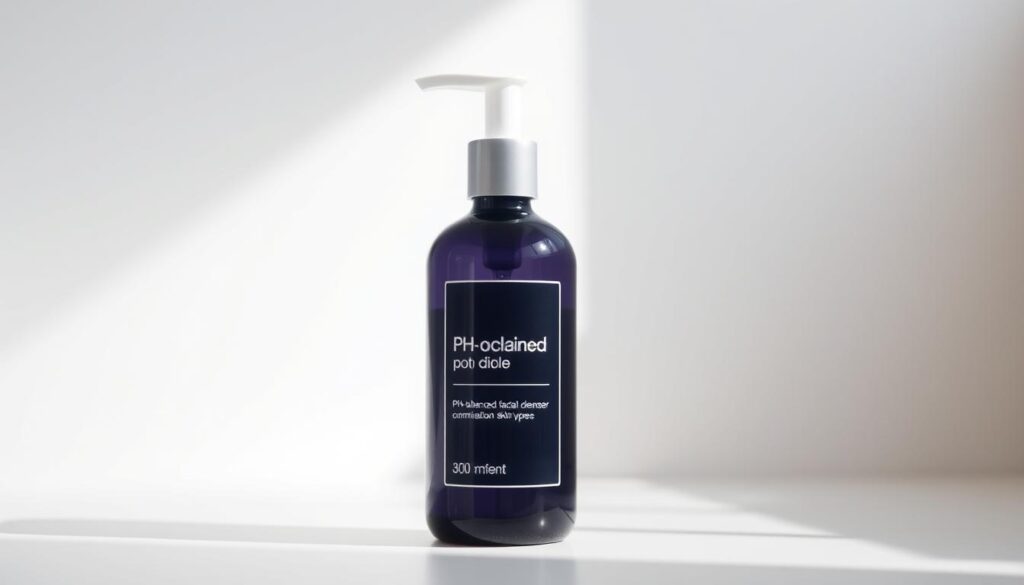
Ingredients to Look For
When selecting a cleanser for combination Skin, look for ingredients like glycerin, which helps retain moisture, and salicylic acid, which can aid in controlling acne and blackheads in the T-zone.
Ingredients to Avoid
Some ingredients can exacerbate combination Skin issues. Avoid cleansers with harsh surfactants that can strip the Skin of its natural oils, leading to increased oil production in some areas and dryness in others.
Double Cleansing Benefits
Double cleansing involves first using an oil-based cleanser to remove makeup and sunscreen, followed by a water-based cleanser to deep clean the pores. This method can be particularly effective for combination Skin, helping to balance the Skin without over-drying or over-oiling.
By choosing the right cleanser and understanding the benefits of techniques like double cleansing, individuals with combination Skin can better manage their Skin’s unique needs.
Effective Toning Strategies
Effective toning strategies are essential for managing the unique challenges of combination Skin. Toning helps balance the Skin’s pH, tighten pores, and prepare the Skin for subsequent products.
Alcohol-Free Formulations
When selecting a toner, it’s crucial to opt for alcohol-free formulations to avoid stripping the Skin of its natural oils. Alcohol can exacerbate dryness in dry areas while potentially irritating the T-zone.
Exfoliating Toners for T-Zone
Exfoliating toners containing ingredients like salicylic acid or glycolic acid can help control oil production and reduce the appearance of pores in the T-zone.
Hydrating Toners for Dry Areas
For dry areas, hydrating toners with ingredients such as rosewater or aloe vera can provide much-needed moisture without clogging pores.
Application Techniques
The application technique is just as important as the toner itself. Gently sweep the toner across the face with a cotton pad, paying special attention to areas of concern.
| Toner Type | Benefit | Suitable Area |
|---|---|---|
| Exfoliating | Controls oil, reduces pores | T-Zone |
| Hydrating | Moisturizes, soothes | Dry Areas |
As skincare expert, Dr. Joshua Zeichner, notes, “Toning is an essential step that can make a significant difference in the overall health and appearance of the Skin.” By choosing the right toner and applying it correctly, individuals with combination Skin can achieve a more balanced and healthy complexion.
Moisturizing Techniques for Combination Skin
Combination Skin requires a thoughtful approach to moisturizing to balance oily and dry areas. Effective moisturizing techniques can help manage the Skin’s diverse needs, ensuring that both oily and dry regions are properly cared for.
Lightweight Gel Formulations
For combination Skin, lightweight gel moisturizers are often an excellent choice. These formulations provide hydration without clogging pores or exacerbating oiliness in the T-zone. Look for gel moisturizers containing hyaluronic acid or glycerin, which help retain moisture in dry areas without feeling heavy.

Zone-Specific Application Methods
Applying moisturizer differently across various zones of the face can be highly beneficial. For the oily T-zone, use a light touch or consider a mattifying moisturizer. In contrast, dry areas such as the cheeks can benefit from a more generous application of a richer moisturizer.
Layering Hydration Strategies
Layering different products can help achieve balanced hydration. Start with a hydrating toner to prime the Skin, followed by a lightweight moisturizer. For dry patches, consider adding a moisturizing Serum or cream on top for extra hydration.
Night Moisturizing Approaches
At night, the Skin benefits from more intensive moisturizing. Use a night cream that’s slightly richer than your daytime moisturizer. This can help repair and hydrate the Skin while you sleep, addressing the unique challenges of combination Skin.
| Moisturizing Technique | Benefit for Combination Skin |
|---|---|
| Lightweight Gel Formulations | Hydrates without clogging pores |
| Zone-Specific Application | Balances oily and dry areas |
| Layering Hydration | Provides customizable hydration levels |
| Night Moisturizing | Repairs and intensely hydrates overnight |
By incorporating these moisturizing techniques into your skincare routine, you can better manage combination Skin, achieving a more balanced and healthy complexion.
Caring for Combination Skin with Targeted Treatments
To effectively care for combination Skin, it’s crucial to employ targeted treatments that address its unique challenges. Combination Skin requires a nuanced approach, balancing oil control in some areas while hydrating others.
Oil-Control Solutions for Shine
For the T-zone, where oiliness tends to be more pronounced, oil-control solutions can help minimize shine. Products containing salicylic acid or glycolic acid can be particularly effective in controlling sebum production and keeping pores clear.
Hydrating Treatments for Dry Patches
Conversely, dry patches on the cheeks or other areas require hydrating treatments to lock in moisture. Look for products rich in hyaluronic acid, ceramides, or niacinamide, which help to repair the Skin’s barrier and retain moisture.
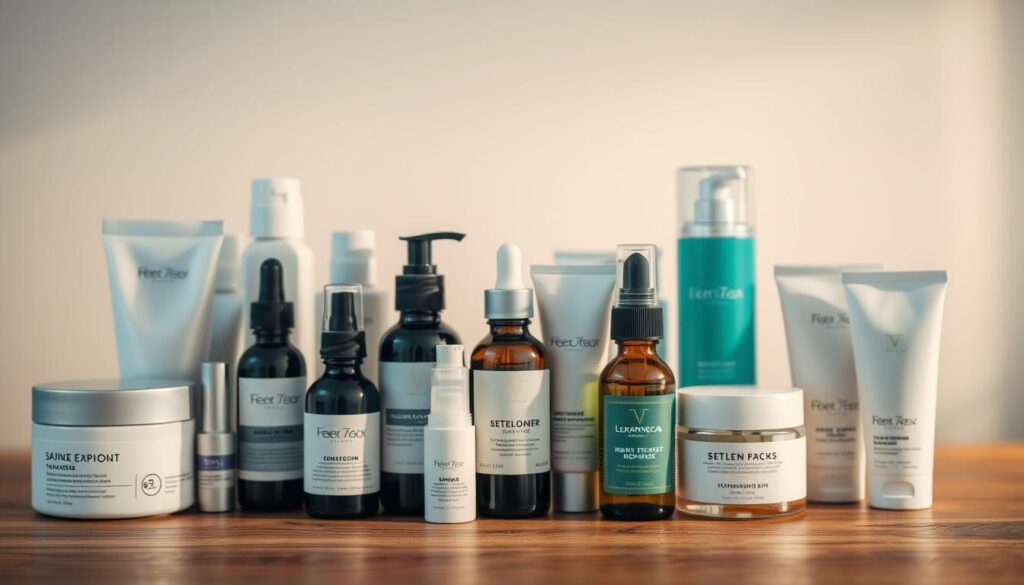
Multi-Masking Techniques
Multi-masking is a technique that involves applying different masks to different areas of the face based on their specific needs. For combination Skin, this might mean applying a clay mask to the T-zone to absorb excess oil, while using a hydrating mask on dry areas to nourish and moisturize.
Spot Treatments for Breakouts
Even with careful skincare, breakouts can still occur. Spot treatments containing ingredients like benzoyl peroxide or sulfur can help to quickly reduce the appearance of pimples and prevent further inflammation.
| Treatment Type | Key Ingredients | Benefits |
|---|---|---|
| Oil-Control Solutions | Salicylic Acid, Glycolic Acid | Reduces shine, controls sebum production |
| Hydrating Treatments | Hyaluronic Acid, Ceramides, Niacinamide | Repairs Skin barrier, retains moisture |
| Multi-Masking | Varies by mask type | Customized treatment for different Skin areas |
| Spot Treatments | Benzoyl Peroxide, Sulfur | Reduces acne, prevents inflammation |
Common Mistakes to Avoid with Combination Skin
Combination Skin requires a nuanced approach, and steering clear of common pitfalls is crucial for optimal Skin health. Many individuals inadvertently exacerbate their Skin issues by making a few prevalent mistakes.
Over-Cleansing Dangers
One of the most common errors is over-cleansing. While it might seem logical to thoroughly clean the T-zone to combat oiliness, over-cleansing can strip the Skin of its natural oils, leading to increased oil production and dryness on the cheeks.
Misusing Astringent Products
Astringent products can be beneficial for oily areas, but using them on dry areas can cause irritation and dryness. It’s essential to apply astringents judiciously, focusing on the T-zone.
Skipping Moisturizer
Skipping moisturizer is another common mistake. Even oily Skin needs hydration to maintain balance. Using a lightweight moisturizer can help hydrate dry areas without exacerbating oiliness.
Using the Wrong Sunscreen
Using the wrong sunscreen can also be detrimental. Combination Skin benefits from lightweight, non-comedogenic sunscreens that protect without clogging pores or adding excess oil.
Ignoring Diet and Lifestyle Factors
Ignoring diet and lifestyle factors can impact Skin health. A balanced diet rich in fruits, vegetables, and whole grains, along with adequate hydration and stress management, can significantly improve Skin condition.
| Common Mistake | Consequence | Correction |
|---|---|---|
| Over-Cleansing | Increased oil production and dryness | Cleanse gently, twice a day |
| Misusing Astringent Products | Irritation and dryness on dry areas | Apply astringents only to oily areas |
| Skipping Moisturizer | Imbalanced Skin hydration | Use a lightweight moisturizer |
Conclusion: Embracing Your Combination Skin
Caring for combination Skin can be challenging, but with the right strategies, you can achieve a balanced and healthy complexion. By understanding your Skin’s unique needs and using the right products, you can effectively manage the T-zone’s oiliness and dry cheeks.
Embracing your combination Skin is about finding a routine that works for you and being confident in your skincare choices. With a consistent routine and the right products, you can enjoy healthy, radiant Skin that looks and feels its best.
Developing skincare confidence takes time and patience, but the payoff is worth it. By following the tips outlined in this article, you can take control of your combination Skin and achieve a more balanced, healthy complexion, ultimately embracing your combination Skin and feeling confident in your own Skin.





